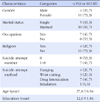Abstract
Purpose
This study is conducted to develop a crisis intervention program for suicide attempters in psychiatric inpatients, and to evaluate its effectiveness.
Methods
The program was developed based on cognitive behavioral therapy. A single group pre-post test design was used with 15 patients admitted to a psychiatric unit for suicide attempt to evaluate the effectiveness on suicide ideation, depression, hopelessness, and problem solving ability. Data were analyzed using SPSS/WIN program.
Results
The developed program was composed of six sessions; orientation and contraction, assessment of suicide risk factors and protect factors, safety planning, reconstruction of negative cognition, enhancing problem solving ability, empowering hope. The crisis intervention program significantly decreased depression (Z=3.35, p=.001), hopelessness (Z=2.92, p=.003), suicide ideation (Z=2.92, p=.003), and improved problem solving skill (Z=-1.99, p=.046).
Figures and Tables
References
1. Aseltine RH Jr, James A, Schilling EA, Glanovsky J. Evaluating the SOS suicide prevention program: A replication and extension. BMC Public Health. 2007; 7:161.
2. Beck AT. The diagnosis and management of depression. Philadelphia: University of Pennsylvania Press;1967.
3. Beck AT, Kovacs M, Weissman A. Assessment of suicidal intention: The scale for suicide ideation. J Consult Clin Psychol. 1979; 47:343–352.

4. Beck AT, Weissman A. The measurement of pessimism: The Hopelessness Scale. J Consult Clin Psychol. 1974; 42:861–865.

5. Biddle L, Brock A, Brookes ST, Gunnell D. Suicide rates in young men in England and Wales in the 21st century: Time trend study. BMJ. 2008; 336:539–542.

6. Brown GK, Ten Have T, Henriques GR, Xie SX, Hollander JE, Beck AT. Cognitive therapy for prevention of suicide attempts. JAMA. 2005; 294:563–570.

7. Choi DC, Kim HY, Kim CH, Park SH, Kim SH, Cho YR, et al. Sociodemographic characteristics of the suicide attempters visiting emergency room. Korean J Psychopathol. 2000; 9(1):36–49.
8. Choi YH, Mo KB, Kim MS, Kim NC, Park SY, Lee YH, et al. Hopelessness: A literature review of the concept for nursing. J Korean Acad Adult Nurs. 1989; 1:5–18.
9. Coleman C, Casey JT. Therapeutic mechanisms of suicidal ideation: The influence of change in automatic thought and immature defenses. Crisis. 2007; 28(4):198–203.
10. Gibb SJ, Beautrais AL, Fergusson DM. Mortality and further suicidal behaviour after and index suicidal attempt: A 10 year study. Aust N Z J Psychiatry. 2005; 39:95–100.

11. Heppner PP, Peterson CH. The development and implications of a personal problem-solving inventory. J Couns Psychol. 1982; 29:66–75.

12. Howson MA, Yates KM, Hatcher S. Representation and suicide rates in emergency department patients who self-harm. Emerg Med Australas. 2008; 20:322–327.

13. Jung WY. Risk factors in completed/non-completed suicide and effectiveness of conventional psychiatric treatment on re-attempts. Busan: Busan University;2009. Unpublished master's thesis.
14. Kim KS. Relationship between the degree of self-actualization and the self-perception on problem-solving aptitudes in the university students. Seoul: Ewha Womans University;1986. Unpublished mater's thesis.
15. Lee CS, Kweon YR, Kim SJ, Choi BS. The effect of suicide prevention program on depression, suicidal ideation, and problem solving ability on middle school students. J Korean Acad Psychiatr Ment Health Nurs. 2007; 16:337–347.
16. Lee KH. Treatment of Suicide Patients. J Korean Soc Biol Ther Psychiatry. 2004; 10:15–24.
17. Lee YH, Song JY. A study of the reliability and the validity of the BDI, SDS, and MMPI-D scales. Korean J Clin Psychol. 1991; 10(1):98–113.
18. Lynch TR, Cheavens JS, Morse JQ, Rosenthal MZ. A model predicting suicidal ideation and hopelessness in depressed older adults: The impact of emotion inhibition and affect intensity. Aging Ment Health. 2004; 8:486–497.

19. Marschean A, Kincaid IA. Developing a plan and strategy for suicide prevention in the commonwealth (Senate Document No. 19). Richmond, Virginia: The Joint Commission;2003.
20. Mendez-Bustos P, de Leon-Martinez V, Miret M, Baca-Garcia E, Lopez-Castroman J. Suicide reattempters: A systematic review. Harv Rev Psychiatry. 2013; 21(6):281–295.
21. Nock MK, Borges G, Bromet EJ, Cha CB, Kessler RC, Lee S. Suicide and suicidal behavior. Epidemiol Rev. 2008; 30:133–154.

22. O'Connor RC, Fraser L, Whyte MC, Machale S, Masterton G. A comparison of specific positive future expectancies and global hopelessness as predictors of suicidal ideation in a prospective study of repeat self-harmers. J Affect Disord. 2008; 110(3):207–214.
23. Park BK. Factors associated with adolescents' suicidal ideation. Ment Health Soc Work. 2007; 26:168–193.
24. Park GB, Shin MS. College goal and suicidal ideation among high school students. Korean J Clin Psychol. 1990; 9(1):20–32.
25. Seo HS. Effects of a cognitive-behavioral group counseling program on new generation soldiers with suicide thoughts. Korean J Youth Stud. 2010; 17(10):49–76.
26. Shin MS, Park GB, Oh GJ, Kim JS. The structural relation among depression, hopelessness, and suicidal ideation: A study of suicidal ideation among high school students. Korean J Clin Psychol. 1990; 9(1):1–19.
27. Statistics Korea. The death statistics in 2009. 2010. Retrieved Oct. 28, 2011. from http://kostat.go.kr.
28. Wang AG, Mortensen G. Core features of attemptedsuicide: A long-term follow-up after suicide attempts in low-suicide-incidence population. Soc Psychiatry Psychiatr Epidemiol. 2006; 41(2):103–107.
29. Wenzel A, Brown GK, Beck AT. Cognitive therapy for suicidal patients. Washington: American Psychological Association;2009.
30. Yook SP. The exploration of suicide related variables and the development of treatment program. Seoul: Korea University;2002. Unpublished doctoral dissertation.




 PDF
PDF ePub
ePub Citation
Citation Print
Print





 XML Download
XML Download